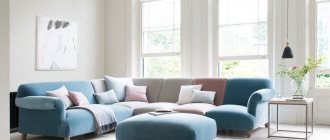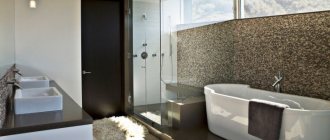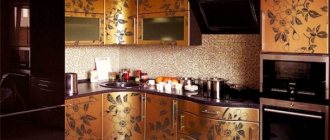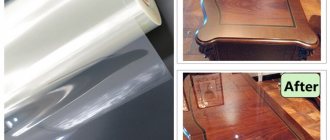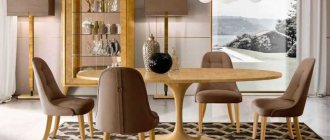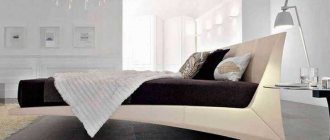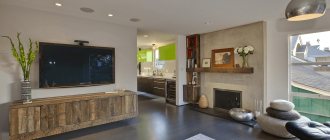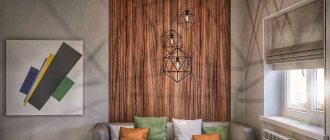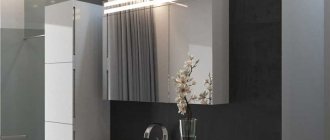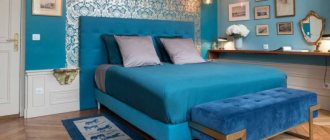Material characteristics
For pasting furniture, films with a polymer-based outer layer are most often used. The main materials are polypropylene, PVC (polyvinyl chloride, vinyl), polyester. The inner layer is an adhesive composition, protected from dust and dirt by a paper backing.
Modern industry offers various film options.
PVC. The material is resistant to aggressive chemicals and most external influences. Frost resistance is low, but it is unlikely that your apartment or house will experience cold temperatures of -15 °C. Susceptibility to ultraviolet radiation depends on the composition. To prevent “fading” in the sun, light-absorbing dyes are added to PVC.
Polyester. Polyester material, resistant to “chemistry” and mechanical stress. High fire resistance. Harmless and recyclable. The material is widely used in outdoor advertising and construction, which indirectly speaks about its characteristics.
Polyester film can be glued to furniture in the kitchen.
Polypropylene. It has the lowest density among all plastics. Abrasion resistant. Insensitive to heat (melts at 175 °C). Sensitivity to ultraviolet radiation is high, but is significantly reduced when special stabilizers are added to the material.
Note! The performance of all furniture upholstery films largely depends on additives. It is impossible to check the composition of impurities in products under domestic conditions. That is why it is worth purchasing covering film only from well-known brands.
Any furniture surface in your home can be revived using film.
In general, self-adhesive decorative films for furniture have the following advantages:
- moisture resistance;
- practicality;
- wear resistance, strength;
- does not require special care;
- immunity to temperature changes;
- resistance to aggressive chemicals, ultraviolet radiation, abrasion.
There are a variety of textures and colors on the market.
There are also disadvantages:
- Only smooth, prepared surfaces can be pasted over. Irregularities will be visually noticeable. Also, in places of defects, the gluing is weaker.
- The surface needs preparation: removing dust and dirt and, in some cases, removing the paintwork.
- It's difficult to make perfect joints. At the slightest inaccuracy, they will be too conspicuous.
- It is difficult to remove from some surfaces.
What is self-adhesive film?
The product is produced in small rolls and resembles ordinary wallpaper in appearance. The main distinguishing feature is the fact that when working with film, no glue is required, only a ruler and scissors.
Self-adhesive film with yellow flowers on the kitchen set
Cabinet decor using self-adhesive film
Self-adhesive is a colored or transparent film made of polyvinyl chloride. On one side there are various images or textures applied, on the other - a special adhesive composition. For example, wood-look film is popular, giving furniture a presentable appearance. In order to stick the product, it is necessary to remove the paper layer that covers the adhesive surface, and then apply the film to the furniture facade.
Self-adhesive film for decoupage technique
Self-adhesive multi-colored film on wardrobe doors
The sticker is one of the types of vinyl films. But it is not a solid canvas, but a special pattern, image, ornament or a real picture with a specific plot. The film is used to decorate various surfaces.
Self-adhesive film in the decor of children's furniture
Self-adhesive pink film in the kitchen
Products are produced in rolls, the width of which can be 45, 67, 50 or 90 cm. The length of such a roll is 2, 8 or 15 meters. The cost of the roll will depend on the listed parameters and characteristics of the material. As a rule, the price varies between 350 – 4500 rubles. The cost of one individual sticker is based on its size and image features. Currently, you can purchase special designer products created by famous designers. Their price will be quite high.
Self-adhesive film for stained glass on door glass
Self-adhesive film with a picture on furniture in the living room
Types of decorative films for furniture
Among the stickers that help update pieces of furniture, the following types can be distinguished:
- Traditional monochromatic options.
- Metallized films. They are characterized by durability and shine when exposed to light.
- Decorative. Such options incredibly realistically imitate various textures: film imitating wood of various species, metal, textiles, mosaic, leather; and they are often decorated with all kinds of images.
- With 3D effect. Create interesting natural visual illusions.
- Transparent options with an ornament or pattern that can be used to paste over glass surfaces.
- Velor. The stickers have a soft velvety surface that is pleasant to the touch.
- Fluorescent. Such models not only provide an updated look for the furniture, but also glow in the dark.
- With the effect of a school board. Suitable for children's rooms because you can write or draw on them.
Self-adhesive film with geometric pattern
Interior self-adhesive film
Types of vinyl film for decoration
In addition to the main material of the working layer, films are divided according to the type of decor into:
- Transparent, translucent, mirror.
- Matte and glossy (plain gloss, hologram, metallic).
- Plain and patterned (patterns, thematic images).
- With imitation of natural textures (mainly stone and wood).
Choose high-quality film for covering furniture.
Plain and patterned
Plain vinyl film can be used to cover walls and interior doors and decorate furniture. Suitable for bringing several interior elements into a single stylistic look. Self-adhesive paper with a bright and cheerful pattern will look good in a nursery.
Trust your child with the choice of film for the children's room.
The design of a child’s room can be changed at least every few weeks, simply by changing the decor of the closet.
Matte and glossy
Homeowners are divided approximately 50/50. Some prefer the practicality of matte surfaces. Others are more attracted by the nobility of gloss. And everyone will justify their choice, and will be right in their own way.
In addition to the material that forms the basis of the furniture film, you need to pay attention to the presence of a protective layer.
The gloss is noble and modern. When used correctly, it can work wonders with the design of a room:
- Change the geometry of space.
- Emphasize the design style.
- Change the perception of the interior color scheme.
But at the same time it needs a little more care. Glossy surfaces are easier to leave marks on. And they are more noticeable.
If you are going to use cladding in the bathroom, be sure to ensure that it has a high degree of moisture resistance.
Matte film has its advantages:
- There is no shine (for many this is more of a plus than a minus).
- Practicality. The matte surface gets dirty less and dirt is less visible on it.
The final choice is a matter of personal preference, a matter of taste.
Mirror
Mirror vinyl film for furniture is also used to decorate walls and ceilings, light partitions and decorative profiles. The main disadvantage is that pasting is carried out only on a perfectly clean and smooth surface. Any unevenness will immediately manifest itself as a change in the angle of refraction of light at the site of the defect.
You need to carefully glue the mirror film, on which bends may be visible.
The main advantages are the same as those of any mirror surface:
- Changing the geometry of the interior space.
- Visual enlargement of the room.
- Improved lighting.
She's like a mirror, only unbreakable. Hence one more requirement. Like any mirror, mirror self-adhesive must be correctly integrated into the interior. Only with a balanced approach to design will this finishing material reveal its advantages to the maximum.
With imitation of natural textures
Decorating furniture with stone-look film is especially popular in kitchens and studios decorated in modern industrial styles. Wood veneer is suitable for all rooms and for the vast majority of interior design types.
Wood imitation film is suitable for covering doors.
Decorative options
In this regard, the number of possible options is almost limitless. The leather-like film gives the room a presentable, expensive appearance. The same characteristics are characteristic of stickers that imitate natural stone or wood. For a modern interior, options that repeat the texture of various fabrics are more suitable. It is enough just to cover the furniture with velor film, and a cozy homely atmosphere will reign in your home. Gold or silver items with gloss will harmoniously fit into the high-tech style.
Self-adhesive film for tiles
Self-adhesive stained glass film on the window
You can always choose a suitable wood-look film, the color of which matches the real texture of the new furniture. Stickers are also suitable for restoring old furnishings. Any surface can be updated.
Film with drawings of a certain theme is often used in a children's room. The decorative coating changes over time depending on the age and interests of the child. A cabinet or table covered with a film with a “blackboard” effect will help your child draw without damaging the wallpaper.
Self-adhesive film on a bathroom cabinet
Criterias of choice
The manufacturer and online stores usually indicate the subject of the product, area of application (rooms, surfaces, types of interior elements), film dimensions (width and length), color, theme, type of working layer (glossy, matte), transparency. The degree of transparency and the presence of a protective layer (from ultraviolet radiation, etc.) may be indicated.
Be creative when designing furniture.
When choosing, you should consider:
- Color scheme, image, transparency, effects (glow in the dark, mirror properties, gloss).
- Conditions (near heating appliances it is worth using self-adhesive tapes with a special thermal protective layer; in areas exposed to direct sunlight - film with ultraviolet stabilizers).
- Surface quality (for rough surfaces, a single-layer cast film is more suitable).
Preparation for pasting
Applying decorative self-adhesive film for furniture should only be done on a prepared surface.
Before applying the film, furniture must be prepared.
Surface preparation
Before covering furniture with film, dust and dirt must be thoroughly removed from the application site. If the surface is not smooth enough, it may be necessary to remove the paintwork and repair any defects.
Uncover
It is better to cut with a small margin and be sure to take into account the ends. You can always cut off the excess, but you won’t be able to carefully “build up” the missing fabric - the joints will be very noticeable. A ruler with a division pitch of 5 mm is applied to a protective paper backing. It's easier to navigate.
Old items can be modified using self-adhesive film.
When preparing to glue a self-adhesive with an image, it is more convenient to cut from the front side. Align the image with your work surface, then draw trim lines.
Pasting process
After taking measurements and cutting off the canvas, carry out the pasting in stages, gradually removing the protective layer, starting from the corner.
Use professional tools to cover furniture surfaces.
Note! It is easier to decorate on horizontal surfaces. So, for example, if you are covering cabinet doors, it is better to first remove them and place them on a table or floor.
What is the material
With the help of self-adhesive film it is possible to update any design. It is not difficult to stick it on different substrates, and the resulting coating has a long service life and is highly attractive.
Film for pasting furniture consists of several layers:
- the front surface is highly durable, and also has a certain pattern and texture, which makes it easy to update any furniture at home;
- glue intended for the procedure of gluing material to different surfaces;
- a protective film that is removed immediately before the self-adhesive film is attached to a specific piece of furniture.
Furniture film is made from different materials, but the most popular are products made from polymers, metallized foil or plain paper.
Self-adhesive films are produced using different technologies. For each method, specialized equipment is used. The following methods are used for this:
- cast color film - this material can be used for kitchen furniture or used in other specific conditions. Self-adhesive products made using this method are durable, easy to use and retain their unique colors for a long time. Photos of them can be seen below. This material is heat-resistant, so it can be used not only for fastening to furniture, but even for packaging furniture. During repairs, it is taken into account that fixation must be carried out exclusively on a base that is ideally even, clean, dry and smooth. This self-adhesive material can be used for chipboard, MDF or other surfaces. This self-adhesive film can cover not only various interior items, but also doors;
- Calendering technology - gluing material made using this method is quite simple. The resulting coating is resistant to shrinkage and other negative factors, but over time it shrinks and therefore loses its attractiveness.
Thus, updating various interior items with a special self-adhesive film for furniture is an excellent solution for every owner of these structures. Self-adhesive film for furniture has many unique parameters, is suitable for gluing various surfaces, and is also intended to protect them from various negative influences.
Gluing to specific surfaces
Plastic, glass and other perfectly smooth surfaces need to be pre-moistened with water and a small amount of dishwashing detergent.
Try to pull the paper evenly.
After pasting, run a soft rag or sponge over the surface of the film, displacing water. Small drawers and doors are usually decorated using the dry method. Additional moisture is convenient for large surface sizes.
In addition to furniture, old doors, glass and even walls are suitable for processing with this material.
It is better to decorate vertical surfaces from the top corner. Gradually separate the protective layer and carefully stick the film onto the wall. You can smooth vinyl with a sponge, a rag, a piece of plastic, or even your hand.
You yourself can easily cope with this task of covering furniture with film.
Read the documentation for the finishing material. The manufacturer often gives recommendations for covering various surfaces with its film.
How to avoid common mistakes
The most common mistakes when covering furniture with film:
- The material is taken end-to-end. It is better to take self-adhesive with a reserve. Then, if the canvas is slightly skewed, it will be possible to trim off the excess, but not re-glue the film completely.
- Poor cleaning of the working surface from dirt.
- It is highly recommended not to remove the entire protective layer at once. This will greatly complicate the gluing process. Detach the backing first at the corner of the canvas, attach it, then gradually remove it, while carefully and gradually gluing the vinyl.
There is no need to look for specialists and pay for the service; you can paste the furniture yourself.
Decorating furniture with film is one of the most affordable and easiest ways to update the appearance of chests of drawers, tables and cabinets. The closest alternative is veneering with natural or artificial veneer. However, this option requires large investments and time.
The advantages of film allow you to cheaply and creatively transform children's rooms.
Self-adhesive is inexpensive, quite durable and resistant to external influences. Large selection - it’s easy to choose the option that best suits the color, texture, pattern, and transparency.
